Based in Ashbourne, Co Meath, Kilmoon Cross Nurseries made the switch to a biomass-powered heating system in 2016. A steady supply of heat is of vital importance to Kilmoon Cross Nurseries explains director, Peter McMahon.
The family run business owns and operates a 3.5-acre glasshouse facility. With his daughter and general manager Andrea, the business produces over 250 plants, including perennials, bedding, patio, basket and pot plants. 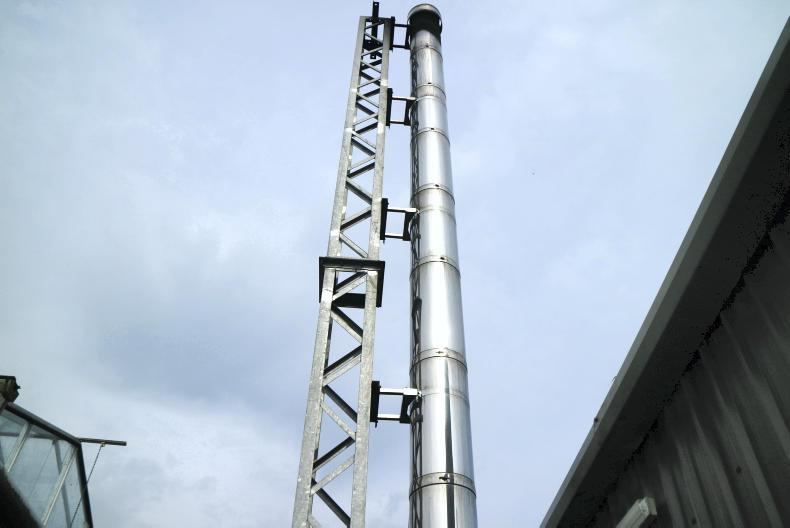
There are virtually no smoke particles coming from the chimney.
His glasshouses must maintain an internal temperature of around 22°C all year round, regardless of outside temperatures. Traditionally, this heating requirement was met by three one megawatt oil burners. Depending on the year, annual oil usage could range from 50,000l to 100,000l.
The journey to biomass began when Peter’s son PJ, a director and horticultural science officer, took part in a one-year Fusion programme with Intertrade Ireland. As a result of this, and in a bid to move away from oil to become greener, the company looked at various forms of bioenergy which could be adopted for their business.
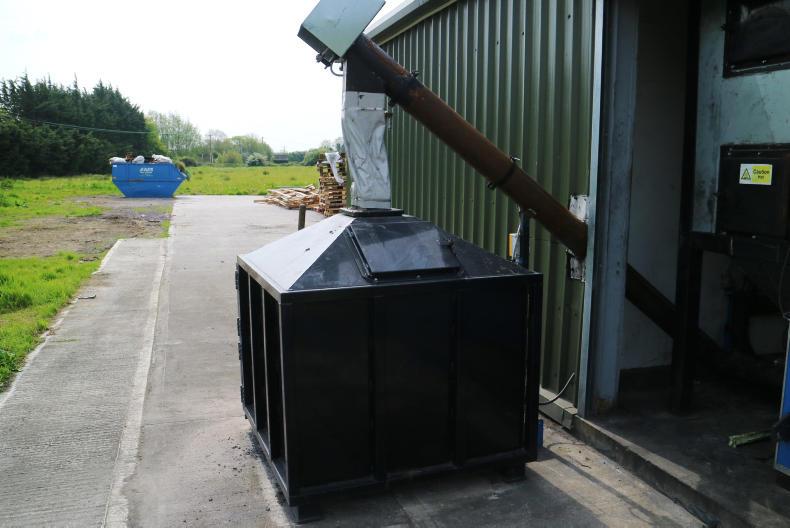
The ashes from the burner are collect in an external tank and used in his nurseries.
After examining solar, wind and biomass, and given the criteria and parameters of the businesses heat requirements, the most suitable system from an investment and return standpoint at the time was biomass, Peter explains.
The boiler
When initially assessing the system, they talked to a number of installers and organisations, including Teagasc. But biomass boilers were still at a relatively early stage, Peter explains, and the system had to be tailor-made to their business requirements.
Peter installed a 800kWh Lin-Ka burner with a Dan Stoker boiler in a purpose-built area behind his glasshouses. The burner is capable of processing multiple fuel types, which attracted him to the system. It now runs off wood pellets.

The bioler and ashe collection tank.
The challenge, however, is designing a system to deliver the fuel source into the burner, he explains. In 2017 and 2018 he installed two 20t hoppers to store the wood pellets. These are fed from the hopper directly into the burner.
The hoppers also help to ensure they have a steady supply of pellets during times of peak demand and allow for storage of 15 days’ worth of pellets.
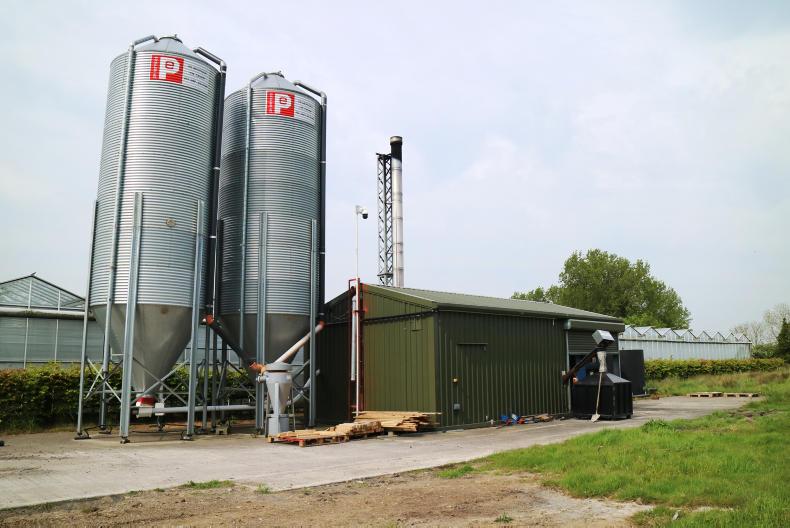
The system cost around €500,000.
Peter also installed a cyclone dust remover, to keep dust to a minimum when blowing pellets into the hopper.
Diesel is injected for two seconds to help ignite the fuel. Water is heated to 90°C before being stored in three 5,000l buffer tanks.
The heated water is then pumped through several miles of 1.5in pipes throughout the glasshouses.

The entire system complete with 15,000l storage capacity.
However, current tank capacity isn’t enough, and Peter is in the process of upgrading his buffer tanks to 80,000l. This will allow him to get maximum use out of his system.
The burner generally runs at nighttime, and when active there is virtually no smoke coming from the chimney, Peter explains. The ashes from the burner are collected in an external tank and used in the nurseries.
He employs an external company that looks after the maintenance of the burner and boiler: “It is critical to have that backup in place.”
Fuel source
In the early days, Peter explored the use of a number of different fuel sources, including energy crops such as miscanthus and willow to fuel the burner. A supply of willow chip was initially sourced locally, and Peter even explored the idea of growing a willow crop on his own land to supply the burner. However, the moisture content and quality of the delivered chip was causing inefficiencies with the burner, and it also proved a challenge for Peter to develop a smooth, consistent supply chain.

The hoppers are equipped with weigh cells.
Eventually, he made the move to imported wood pellets, which have a moisture content of 5% due to the consistency of product and security of supply chain. He is very happy with the performance of the pellets to date.
Peter said that in order for him to switch back to a locally sourced biomass supply, energy crops for example, then the end product would need to be pelletised, have guaranteed moisture and quality specifications and be delivered through a blower system.
Costs
The cost of the entire project, including the infrastructure and additional features and hardware, has so far come to around €500,000.
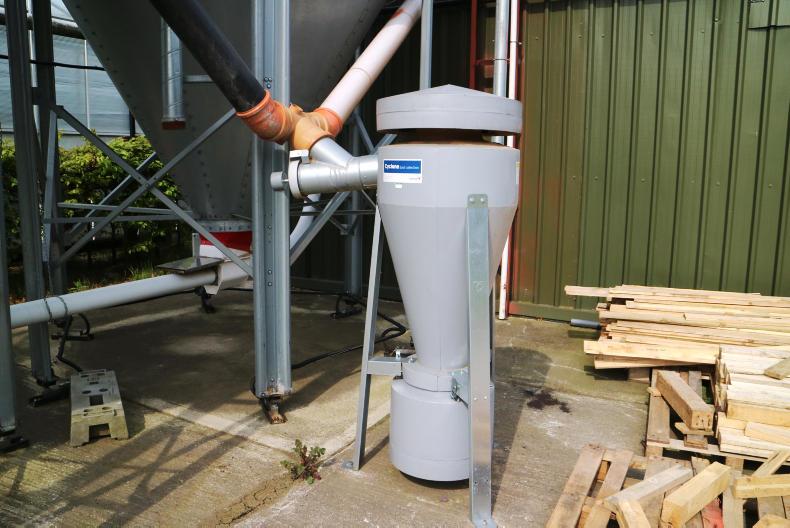
The cyclone dust removed to keep dust to a minimum when blowing chips into the hopper.
However, the ongoing running costs will be lower than that of the oil burner, and there are a lot less components that can go wrong when compared with oil burners.
“I haven’t seen huge savings in actual energy costs from the system just yet, it’s only a very small one because of the price of wood pellets versus oil,” Peter explains.

Everythingh can be controlled from a touch screen panel.
But cost savings are only one aspect of his decision to install the system citing that its more environmentally friendly and, in general, much cleaner than his oil systems.
Support scheme
Last month, the green light was officially given under EU state aid rules for a government scheme to support commercial users of renewable heat fuels. The Support Scheme for Renewable Heat (SSRH) will pay users through degressive annual tariffs for heat generated from renewable sources, including energy crops.
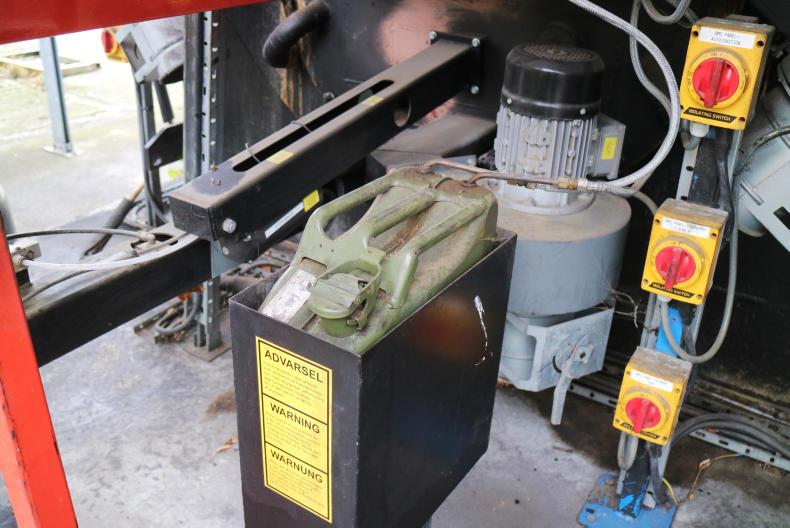
The diesel tank.
Peter fears that as they installed their biomass heating system three years ago, they now won’t be eligible for support under the scheme.
“We wanted to be green and use biomass, but now we are going to be punished because we wanted to do this in 2016,” Peter explains.

Peter McMahon of Kilmoon Cross Nurseries.
He feels that at very least there should be some form of retrospective payment system to reward them for the oil they have displaced over the years.
Advice
When asked about advice for those interested in biomass heating systems, Peter said a business must first ensure that it is sustainable, as any investment is likely to be significant.
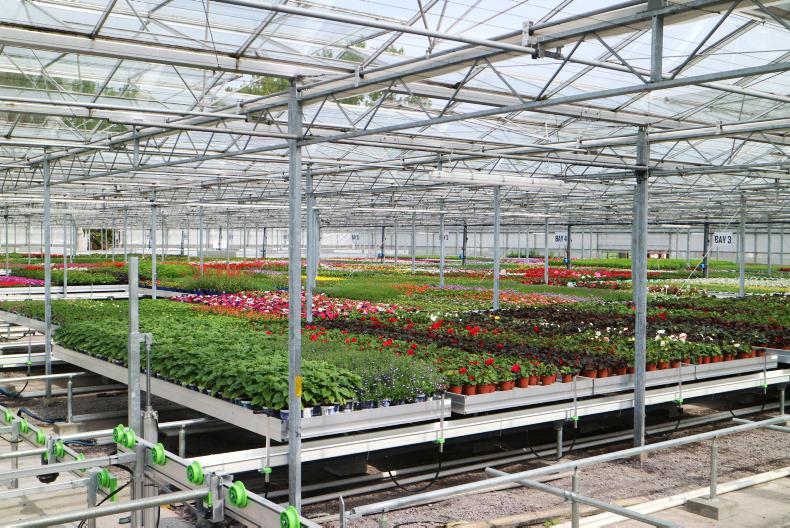
The glass house must be kept at around 24°C.
It must also understand its exact heating requirements and develop a system which meets those. He also stressed the need for a good supplier and installer that will maintain the system going forward, so good research is required.
Read more
Renewable schemes 'too narrow' – IFA
Co-ops prices, renewables, payment delays and EU elections
Based in Ashbourne, Co Meath, Kilmoon Cross Nurseries made the switch to a biomass-powered heating system in 2016. A steady supply of heat is of vital importance to Kilmoon Cross Nurseries explains director, Peter McMahon.
The family run business owns and operates a 3.5-acre glasshouse facility. With his daughter and general manager Andrea, the business produces over 250 plants, including perennials, bedding, patio, basket and pot plants. 
There are virtually no smoke particles coming from the chimney.
His glasshouses must maintain an internal temperature of around 22°C all year round, regardless of outside temperatures. Traditionally, this heating requirement was met by three one megawatt oil burners. Depending on the year, annual oil usage could range from 50,000l to 100,000l.
The journey to biomass began when Peter’s son PJ, a director and horticultural science officer, took part in a one-year Fusion programme with Intertrade Ireland. As a result of this, and in a bid to move away from oil to become greener, the company looked at various forms of bioenergy which could be adopted for their business.

The ashes from the burner are collect in an external tank and used in his nurseries.
After examining solar, wind and biomass, and given the criteria and parameters of the businesses heat requirements, the most suitable system from an investment and return standpoint at the time was biomass, Peter explains.
The boiler
When initially assessing the system, they talked to a number of installers and organisations, including Teagasc. But biomass boilers were still at a relatively early stage, Peter explains, and the system had to be tailor-made to their business requirements.
Peter installed a 800kWh Lin-Ka burner with a Dan Stoker boiler in a purpose-built area behind his glasshouses. The burner is capable of processing multiple fuel types, which attracted him to the system. It now runs off wood pellets.

The bioler and ashe collection tank.
The challenge, however, is designing a system to deliver the fuel source into the burner, he explains. In 2017 and 2018 he installed two 20t hoppers to store the wood pellets. These are fed from the hopper directly into the burner.
The hoppers also help to ensure they have a steady supply of pellets during times of peak demand and allow for storage of 15 days’ worth of pellets.

The system cost around €500,000.
Peter also installed a cyclone dust remover, to keep dust to a minimum when blowing pellets into the hopper.
Diesel is injected for two seconds to help ignite the fuel. Water is heated to 90°C before being stored in three 5,000l buffer tanks.
The heated water is then pumped through several miles of 1.5in pipes throughout the glasshouses.

The entire system complete with 15,000l storage capacity.
However, current tank capacity isn’t enough, and Peter is in the process of upgrading his buffer tanks to 80,000l. This will allow him to get maximum use out of his system.
The burner generally runs at nighttime, and when active there is virtually no smoke coming from the chimney, Peter explains. The ashes from the burner are collected in an external tank and used in the nurseries.
He employs an external company that looks after the maintenance of the burner and boiler: “It is critical to have that backup in place.”
Fuel source
In the early days, Peter explored the use of a number of different fuel sources, including energy crops such as miscanthus and willow to fuel the burner. A supply of willow chip was initially sourced locally, and Peter even explored the idea of growing a willow crop on his own land to supply the burner. However, the moisture content and quality of the delivered chip was causing inefficiencies with the burner, and it also proved a challenge for Peter to develop a smooth, consistent supply chain.

The hoppers are equipped with weigh cells.
Eventually, he made the move to imported wood pellets, which have a moisture content of 5% due to the consistency of product and security of supply chain. He is very happy with the performance of the pellets to date.
Peter said that in order for him to switch back to a locally sourced biomass supply, energy crops for example, then the end product would need to be pelletised, have guaranteed moisture and quality specifications and be delivered through a blower system.
Costs
The cost of the entire project, including the infrastructure and additional features and hardware, has so far come to around €500,000.

The cyclone dust removed to keep dust to a minimum when blowing chips into the hopper.
However, the ongoing running costs will be lower than that of the oil burner, and there are a lot less components that can go wrong when compared with oil burners.
“I haven’t seen huge savings in actual energy costs from the system just yet, it’s only a very small one because of the price of wood pellets versus oil,” Peter explains.

Everythingh can be controlled from a touch screen panel.
But cost savings are only one aspect of his decision to install the system citing that its more environmentally friendly and, in general, much cleaner than his oil systems.
Support scheme
Last month, the green light was officially given under EU state aid rules for a government scheme to support commercial users of renewable heat fuels. The Support Scheme for Renewable Heat (SSRH) will pay users through degressive annual tariffs for heat generated from renewable sources, including energy crops.

The diesel tank.
Peter fears that as they installed their biomass heating system three years ago, they now won’t be eligible for support under the scheme.
“We wanted to be green and use biomass, but now we are going to be punished because we wanted to do this in 2016,” Peter explains.

Peter McMahon of Kilmoon Cross Nurseries.
He feels that at very least there should be some form of retrospective payment system to reward them for the oil they have displaced over the years.
Advice
When asked about advice for those interested in biomass heating systems, Peter said a business must first ensure that it is sustainable, as any investment is likely to be significant.

The glass house must be kept at around 24°C.
It must also understand its exact heating requirements and develop a system which meets those. He also stressed the need for a good supplier and installer that will maintain the system going forward, so good research is required.
Read more
Renewable schemes 'too narrow' – IFA
Co-ops prices, renewables, payment delays and EU elections












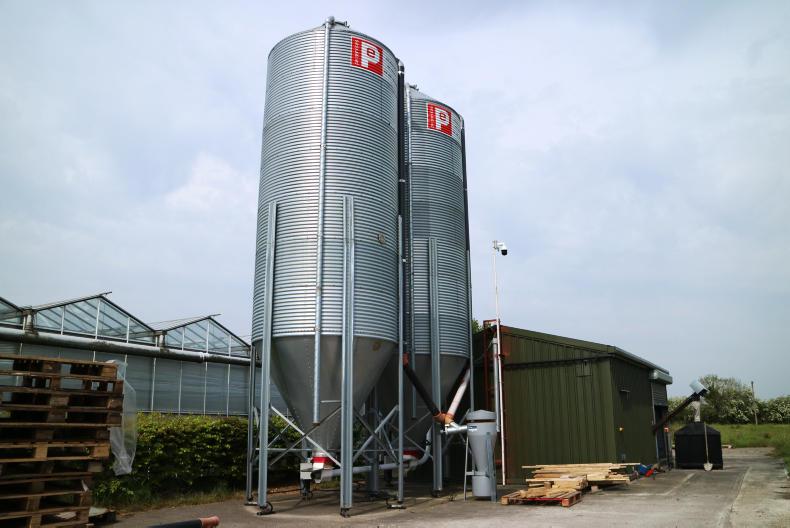




 This is a subscriber-only article
This is a subscriber-only article










SHARING OPTIONS: